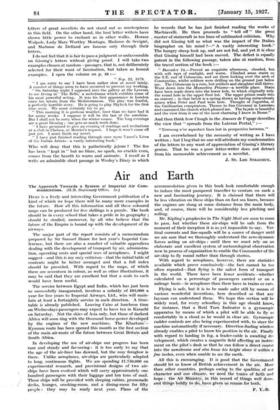Air and Earth
The Approach Towards a System of Imperial Air Com- munications. (H.M. Stationery Office. 5s.) HERE is a lively and interesting Government publication of a kind of which we hope there will be many more examples in the future. How all this information and all these coloured snaps can be produced for five shillings is a puzzle. The book should be in every school that takes a pride in its geography ; should be studied, moreover, by all who believe that the future of the Empire is bound up with the development of its airways.
The major part of the report consists of a memorandum prepared by Sir Samuel Hoare for last year's Imperial Con- ference, but there are also a number of valuable appendices dealing with the development of transport by air, administra- tion, operating costs and special uses of aeroplanes. I might suggest—and this is my on'y criticism—that the initial table of contents might be better arranged and that a full index should be provided. With regard to the maps, of which there are seventeen in colour, as well as other illustrations, it may be said that they are excellent but that a scale to each would have been useful.
The service between Egypt and India, which has just been so successfully inaugurated, involves a subsidy _of £95,000 a year for five years to Imperial Airways, Ltd., who will main- tain at least a fortnightly service in each direction. A time- table is already published. Leaving Cairo at luncheon time on Wednesdays passengers may expect to have tea in Karachi on -Saturday. Not the skies of Asia only, but those of darkest Africa will soon ring with the thousand horse-power developed by the engines of the new machines. The Ithartuin=-- Ky-sumu route has been opened this month as the first 'Section of the main air-route of t'he future between Great Britain and South Africa.
In developing the use of air-ships our progress has been sure and steady and far-seeing : it is too early to say that the age of the air-liner has dawned, but the rosy foreglow is there. Unlike aeroplanes, air-ships are particularly adapted to long, continuous flights. We are spending- £1,750,000 on experimental research, and provisional designs of two air- ships have been evolved which will carry apprOxiMately one hundred passengers with their ltigigage*and ten tons of mail. These ships will be provided with sleeping cabins, promenade decks, lounges, smoking-room, and a dining-rOom* for -fifty people : they may be ready next year. Plans of the accommodation given in this book look comfortable enough to induce the most pampered traveller to venture on such a new and fascinating journey. It is claimed that there will be less vibration on these ships than on fast sea liners, because the engines are slung at some distance from the main body, and, of course, there will be considerably less pitching and rolling.
Mr. Kipling's prophecies in The Night Mail are soon to come to pass, but whether these air-ships will be safe from the moment of their inception it is as yet impossible to say. Ver- tical currents and line-squalls will be a source of danger until we are sure that we thoroughly understand the sere-dynamic forces acting on air-ships : until then we must rely on an elaborate and excellent system of meteorological observation now in process of organization to enable the Commander of the air-ship to fly round rather than through storms.
With regard to aeroplanes, however, there are statistics available which prove conclusively—the fact cannot be too often repeated—that flying is the safest form of transport in 'the world. There' have been fewer accidents—whether calculated on a percentage of passengers carried or on a mileage basis—in aeroplanes than there have in trains or ears.
Flying is safe, but it is to be made safer still by means of various wonderful inventions, here described so that any layman can understand them. We hope this section will be widely read, for every schoolboy in this age should know, for instance, that a Reid Turn Indicator is a gyroscopic apparatus by means of which a pilot will be able to fly as comfortably in a cloud as he would in clear air. Gyroscopic rudder controls are also being experimented with, to steer the machine automatically if necessary. Direction-finding wireless already enables a pilot to know his position in the air. Finally with regard to landing in fog, a leader-cable is awaiting de- velopment, which creates a magnetic field affecting an •instru- ment on the pilot's dash so that he can follow'a direct course into the aerodrome and also know his height 'above' it within a few inches, even when unable to see the earth.
All this• is encouraging. It is good that the Government should let us know of British achievement in the air. More than other countries, perhaps owing to the qualities of our character and our climate, we need the tonics of faith- and hope : the Air Ministry, in this record of things well done, and thingsboldly to do, ,have given us reason for both.
F. Y.-B.


































 Previous page
Previous page